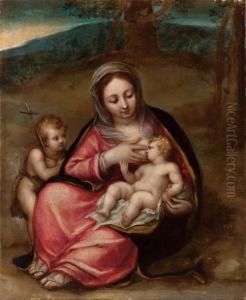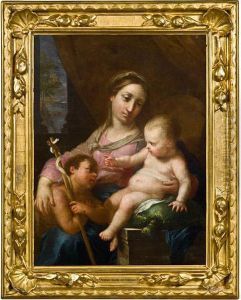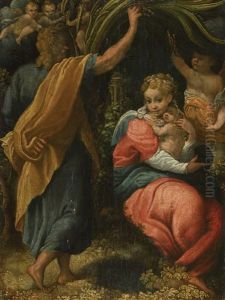Pomponio Allegri Paintings
Pomponio Allegri, born in 1521 in Correggio, Duchy of Modena (now Italy), was a distinguished Italian painter of the late Renaissance period, continuing the legacy of his famous father, Antonio Allegri da Correggio, one of the major figures of the High Renaissance. While much of Pomponio's life is overshadowed by the colossal reputation of his father, he carved out his own niche in the art world of the 16th century, primarily working in Northern Italy.
Pomponio's training and early career were profoundly influenced by his father's work, and he spent a significant part of his life managing and executing commissions that were either left unfinished by his father upon his death in 1534 or those that were inspired by Antonio's style and techniques. Despite the challenge of emerging from his father's shadow, Pomponio developed a style that, while reflective of his father's influence, also incorporated elements of the Mannerist movement that was gaining popularity during his lifetime.
The body of Pomponio Allegri's work includes religious themes, a common focus for artists of his time, with his contributions being primarily frescoes and altarpieces in churches around Correggio and Parma. His works are noted for their vibrant color, expressive figures, and the emotional intensity characteristic of the late Renaissance period. However, compared to his father, Pomponio's works are considered more conventional, lacking the innovative use of light and perspective that made Antonio's paintings stand out.
After his father's death, Pomponio took over the Allegri workshop and was responsible for the completion of several of Antonio's projects. His efforts to preserve and continue his father's artistic legacy, however, did not always translate into the recognition Pomponio might have hoped for himself. Throughout his career, he struggled to establish an independent reputation that could rival that of his father's. Despite these challenges, Pomponio's dedication to his craft and his role in maintaining the Allegri family's presence in the Italian art scene of the 16th century are noteworthy.
Pomponio Allegri died in 1596, leaving behind a modest but important body of work that contributes to our understanding of the transition from the High Renaissance to Mannerism in Northern Italy. While his achievements may not have garnered the same level of acclaim as his father's, his efforts in preserving and continuing the Allegri artistic tradition are an integral part of the history of Italian Renaissance art.





